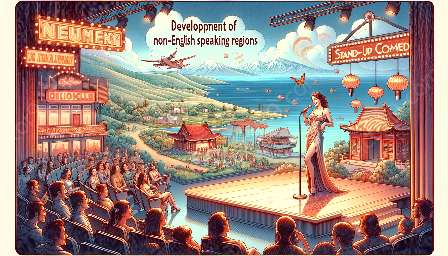Stand-up comedy is a diverse and dynamic art form that reflects and responds to different cultural sensibilities. When exploring cross-cultural differences in stand-up comedy, one intriguing aspect to consider is the use of non-verbal comedy. This topic cluster delves into the cultural implications of non-verbal comedy and its impact on various societies, embracing the uniqueness and diversity of comedic expression around the world.
Cultural Diversity in Stand-Up Comedy
Stand-up comedy is deeply rooted in cultural and social contexts, with comedians drawing inspiration from their own experiences, traditions, and values. Cross-cultural differences in stand-up comedy highlight the varied sources of humor and the ways in which audiences from different backgrounds perceive and respond to comedic acts. From the use of language and wordplay to the interpretation of social norms and taboos, stand-up comedy offers a fascinating lens through which to explore the rich tapestry of human culture.
Non-Verbal Comedy Across Cultures
Non-verbal comedy, characterized by physical humor, facial expressions, and gestures, transcends linguistic and cultural barriers. Its universal appeal lies in its ability to evoke laughter and convey emotions without reliance on spoken language. When examining the cultural implications of non-verbal comedy, it becomes evident that certain physical gestures or actions may carry different meanings or levels of humor in varying cultural contexts. This diversity adds depth to the global comedic landscape and reinforces the idea that humor is a complex and nuanced cultural phenomenon.
Effect of Non-Verbal Comedy
The use of non-verbal comedy in stand-up acts can have profound cultural implications. By tapping into universal human experiences and emotions, non-verbal comedy can create connections and foster understanding across diverse cultures. Furthermore, it enables comedians to engage with audiences whose languages they might not speak, breaking down communication barriers and promoting cross-cultural appreciation. Whether through slapstick humor, mime, or physical improvisation, non-verbal comedy enriches the cultural exchange within the stand-up comedy sphere.
Embracing Cultural Diversity
Understanding and appreciating the cultural implications of non-verbal comedy in stand-up acts enriches our awareness of the vast spectrum of human expression. By celebrating the differences in comedic styles and the ways in which humor is interpreted across cultures, we not only broaden our own perspectives but also foster an environment of inclusivity and empathy. The global reach of non-verbal comedy underscores the interconnectedness of humanity and the power of laughter to transcend cultural boundaries.
Conclusion
Exploring the cultural implications of non-verbal comedy in the context of cross-cultural differences in stand-up comedy provides a compelling window into the complexity and richness of human interaction. By acknowledging and celebrating the diverse ways in which humor is manifested and shared, we can cultivate a deeper understanding of the cultural tapestry that shapes the comedic landscape worldwide.
























